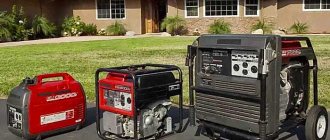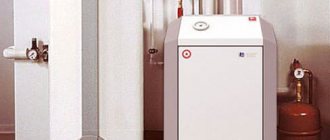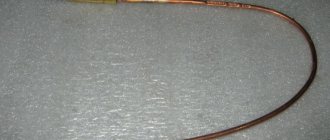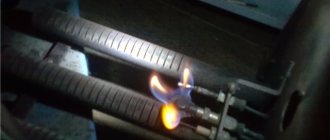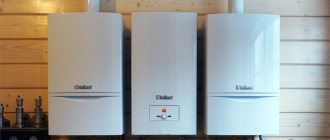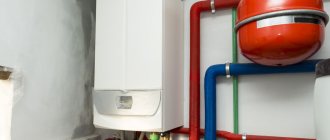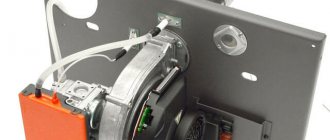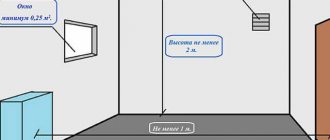A stabilizer for boiler equipment is necessary to protect pumps and automation units from power surges and clean them from frequency distortions. It is used in gardens, country houses, and rural houses where there is instability in the electrical network. The device protects precision equipment responsible for the operation of the heating system from damage. Selection indicators: pump or control unit power taking into account starting currents, error value, overall dimensions.
POWERMAN AVS 500 S – affordable price
Single-phase stabilizer for working with gas boiler equipment with a power of up to 200~300 watts. It is small in size and weight. Made in a wall-mounted version. Equipped with a European output socket. Stabilizes the input parameters of the electric current.
Built-in filters cut off extraneous frequency noise and remove interference. Visual control is carried out on a liquid crystal display. The current state of the structure is reflected by light indicators.
Pros:
- Compact, light weight, fulfills its functions.
- Peak load and short circuit protection.
- Inexpensive, easy to install and connect.
Minuses:
- The socket is at the bottom, slightly inconvenient.
- For some reason there is no second indicator.
Recommendations: 12 best gas boilers
13 best solid fuel boilers
14 best electric boilers
In what case is it advisable to use a UPS instead of a stabilizer?
In addition to voltage stabilizers, there are also uninterruptible power supplies (UPS), which provide a constant volt value and can provide voltage to boiler equipment. Their difference lies in the presence of batteries that provide backup current even when the power in the house is completely turned off. The duration of power supply depends on the battery capacity, and the latter is directly related to the size of the equipment and cost.
It is not advisable to buy an IPB when there are no long power outages. If in an apartment building or village the voltage sometimes disappears (breaks in the line, drop below 100 V from user loads), the stabilizer will turn off the boiler and wait for the power to be restored. Since the heating has a large temperature reserve, the system will not shrink after 5-6 hours of inactivity, even in the most severe frosts. As soon as the voltage level is restored to the minimum allowable according to the stabilizer’s passport, it will pass it through and the boiler automation will start working again.
But if power outages occur for a long time (the light went out in the evening and appeared only the next day at lunch), and this happens once a month, then you should think about purchasing an UPS. Using batteries, the device will be able to provide power to the boiler and pump, which will prevent the coolant from cooling down.
Its principle of operation is to accumulate energy in batteries while there is voltage in the network, and release current to consumers in the event of a general shutdown. The transition from external voltage to internal voltage occurs instantly, so the equipment continues to work. The disadvantages of the UPS include more complex maintenance, increased housing size, and high cost.
UPS types
Uninterruptible power supplies are structurally divided into two types:
UPS with built-in battery. They have a small reserve due to the low battery capacity. Designed to maintain the functionality of the boiler electronics, and possibly equipment alarms (low-flow networks).
UPS connected to external batteries. This is a more advanced type of equipment that is capable of powering the boiler, pumps, and ensuring the operation of solenoid valves and other actuators. With their help, you can survive long blackouts without any consequences for the indoor microclimate.
UPS architecture type
Equipment with batteries is divided into three types according to their design architecture:
- Offline. They operate without a built-in stabilizer, so as soon as the network indicators become unacceptable, they switch to battery operation. If the input current parameters change frequently, the battery will be used regularly and will quickly discharge.
- Online. Has an increased number of batteries and produces double current conversion. The battery is constantly recharged, and the boiler receives voltage from the battery, converting 36 V DC to 220 V AC. Optimally suitable for boiler equipment, but expensive.
- Linear interactive. At the same time, the battery is recharged and voltage is supplied to the boiler, leveling the indicator to 220 V. It is distinguished by sufficient accuracy of the output voltage and an average price.
Comparison of voltage stabilizers and UPS
| Stabilizer | UPS | |||||||
| In what case is it advisable to use. | During short-term power surges and rare power outages. | With frequent power outages for long periods. | ||||||
| Principle of operation. | Eliminates short-term power surges and stabilizes voltage. | As long as there is electricity, the batteries are charged; during a power outage, the batteries are a source of electricity. | ||||||
| Service. | Simple. | More complicated due to the presence of batteries. | ||||||
| Device size. | The device is compact. | The dimensions of the device are large. | ||||||
| Price. | Lower than UPS. | High. | ||||||
To summarize, we can highlight the main points: a voltage stabilizer is essential to protect the gas boiler; It is important to calculate its power with a reserve according to the formula, select a speed of 5-10 ms. The protection and restart functions are important. For prolonged power outages, it is better to choose a UPS with online architecture.
If you notice an error, a non-working video or link, please select a piece of text and press Ctrl+Enter .
0
LENZ TECHNIC R500W – accuracy and price
Automated input voltage stabilization device. Used in private homes, medical institutions, office and administrative premises. Built-in protection mechanisms against overheating and overload during intensive work.
The stabilizer has low error and high accuracy of output parameters. It is possible to connect two consumers with a total power not exceeding 500 watts. It neutralizes a wide voltage range and has a 100% power factor.
Pros:
- Compact, accurate, low level of error.
- Bright color LCD screen. Easy connection.
- My two consumers are powered by a gas boiler and a circulation pump.
Minuses:
- Operation in 0.02 seconds, there are better indicators.
Prices: summary table
| Model | Power, W | Input voltage, V | Error, % | Response time, ms | Cost, rub. | Our rating (0-5 points) |
| Huter 400GS | 350 | 110-260 | 8 | 7 | 3 750-3 920 | 3 |
| BASTION Teplocom ST-555-I | 300 | 165-260 | 8 | 20 | 4 200-5 400 | 3,5 |
| Powerman AVS 1000 D Black | 500 | 140-260 | 8 | 5-7 | 1 920-2 850 | 4,0 |
| RUCELF BOILER-400 | 400 | 150-250 | 8 | 10 | 3 700-4 599 | 4,0 |
| Energy APC 500 | 350 | 85-270 | 4 | 10 | 5 200 | 4,8 |
| Shtil InStab IS550 | 400 | 90-310 | 2 | 0 | 5 680-6 400 | 4,9 |
Rucelf BOILER-600 – application in dachas
The design is specially designed to work in tandem with heating equipment in conditions of unstable power grid indicators. Used in rural areas, places with constant voltage fluctuations.
Designed to work with gas boilers, heating equipment control units, circulation pumps, household and electronic appliances. Has a wide input voltage range. Does not distort the sine wave.
Pros:
- Clear operation, works well with a gas boiler.
- Quick installation and connection, affordable price.
- Quiet, durable body.
Minuses:
- Consumers do not note any shortcomings.
Which voltage stabilizer for a boiler is better to buy?
You should first select a voltage stabilizer based on the type of network in the room. Based on this, a single-phase or three-phase option is chosen so that its power is sufficient to suppress power surges. After this, the power of all consumers in the network is assessed so that the stabilizer has this parameter no lower. Two important parameters can complete the selection process - efficiency and percentage of error.
After comparing the leaders of 2022, the following conclusions can be drawn:
- The best-selling model with a low price is Resanta ACH-30000/3-C;
- The best relay voltage stabilizer is Energy APC 1000;
- The best three-phase model for heating boilers is Rucelf SDV-3-15000;
- The best electronic device for current stabilization is Lider PS6W-30;
- The most accurate, powerful and fastest device is Shtil IS3115RT.
It is important to remember that the choice is made strictly according to the available indicators of the electrical network and heating equipment, needs, and budget. And the list of nominees, their characteristics, pros and cons will help you narrow down your search.
DAEWOO DW-TM1kVA – quality and power
Single-phase wall-mounted voltage stabilization device. It is distinguished by high build quality and stable output indicators. The response time does not exceed 20 milliseconds. The total power allows you to connect two consumers, taking into account the magnitude of the starting currents.
Reliability of control is ensured by an electronic unit based on microprocessors. The stabilizer has a low level of its own noise. Provides protection against short circuit, overload and overheating.
Pros:
- High-quality assembly, nice design, powerful.
- Filters, short circuit protection. Doesn't make any noise at all when the voltage isn't floating.
- Bright and large display, easy wall mounting, connection of two consumers.
Minuses:
- The cord is terribly short, and you can’t hang it close to the boiler - it can heat up.
- Beautiful and poorly informative instructions.
Rating of voltage stabilizers for boilers
It is impossible to say for sure which voltage stabilizers are good and which are not. Each manufactured unit of goods has its own advantages and disadvantages for a particular area of application. Experts examined modern and popular models. And the rating was compiled on the basis of criteria by which one can determine which voltage stabilizer is better. Among them are the following:
- Phase - one or three phases;
- Input and output voltage;
- Power;
- Performance – reaction speed, response time;
- Protective functions, presence of restart;
- Design execution;
- efficiency;
- Additional features - indication, temperature range.
Not only these parameters predetermined the best voltage stabilizers for the boiler; reviews from users of such units are no less important. It is worth noting that there are several types of stabilizers - electromechanical, relay, electronic, single-phase and three-phase. Only by deciding on the characteristics, strengths, and weaknesses of each nominee can you make the right choice.
The best heaters for a summer house
RUCELF BOILER-1200 – protection of boiler units
Single-phase stabilizer for reliable provision of boiler heating equipment with stabilized voltage. It is implemented in a wall-mounted version, which allows you to save space and make more efficient use of the room area.
Levels out voltage surges and eliminates impulse noise. Works over a wide input range. It has a high motor life, the internal components are enclosed in a durable and rigid steel body.
Pros:
- Performs basic functions successfully and works in a basement environment.
- Powerful – boiler and circulation boiler connected.
- Durable, rigid case, small in size, mounted on the wall.
Minuses:
- No input fuse.
Is it necessary to stabilize at all?
To answer this question, let's first look at what components are included in the electric boiler and are they afraid of the “wrong” voltage?
Control board
More precisely, not the board itself, but the power supply included in it.
Old boards have transformer power supplies (can be distinguished by the presence of a heavy trans with a metal core), while new ones are all pulsed (they are produced by small, lightweight transformers with a ferrite core).
Both control boards should perform well in the standard phase voltage range (220V±10% or 230V±10%). Otherwise, the boiler simply will not pass certification.
As a rule, the manufacturer, when choosing the element base, additionally includes a solid margin of reliability in the circuit, so the actual operating range is always much wider than indicated in the instructions.
What is stated in the instructions? Here, for example, is a fragment of the instruction manual for Vaillant eloBLOCK boilers:
Here the manufacturer is clearly playing it safe a little. Below it will become clear why.
In the instructions for the Evan Warmos RX boiler, they have already discarded false modesty and written it as it is:
160...260 Volts is a significant spread, isn’t it? Generally speaking, this even covers the operating range of some stabilizer models.
In fact, I have repeatedly held control boards from boilers in my hands, on which the operating voltage range is indicated - from 100 to 280 V. And 140-160 volts is generally a comfortable value for them.
So, conclusion No. 1: for normal operation of the control board of an electric boiler, a stabilizer is not required.
Go ahead.
Heating elements (electrodes, heating elements)
With electrode-type heaters, everything is simple - they don’t care what the voltage is in the outlet. If the voltage is higher than the rated voltage, the boiler power will be higher. And, accordingly, vice versa.
But with classic tubular heaters (heating elements) the situation is a little more interesting.
Reduced voltage does not threaten heating elements in any way, this is obvious. Due to increased voltage, of course, they will burn out after some time, but for this to happen, the voltage must rise significantly above normal. As practice shows, this happens extremely rarely. Ordinary scale is worse for heating elements than any “wrong” voltage.
The main problem is that the power of the heating elements is a quadratic function of voltage, which is described by the well-known formula:
P = U2 / R [W], where U is the voltage on the heater, V R is the heater resistance, Ohm
The graph of power versus voltage for one of the electric boilers is shown in the figure and represents a classic parabola, or rather its positive branch.
It can be seen that reducing the voltage by only 10% (up to 200V) leads to the boiler losing 1/5 of its power. And a decrease in network voltage by 20% (to 175V) reduces the maximum power of the boiler by a whole third!
Thus, in order to prevent a decrease in the power of the electric boiler, it would be very good to use a voltage stabilizer. But let’s not rush to conclusions and look at this situation from the point of view of financial costs.
Let's assume that we have made calculations and found out that to heat the room we need a 6 kW boiler. How can you squeeze such power out of a boiler under low voltage conditions?
Method one: stabilizer
Considering that in our cottage community there is often low voltage (typical value ~170 V), we decide to connect the electric boiler through a stabilizer. This will allow us to obtain the 6 kW of thermal power we need even at such a low voltage.
Since the maximum power output by the stabilizer also depends on the supply voltage (see dependence graph), for our purpose we need a stabilizer with a power of 8 kW or more.
Of all the existing types of stabilizers, the cheapest are relay ones (see the table of cost per kilowatt of power), so we will choose these models:
- Wester STB-10000 , floor-standing, 140-260 V, 8 kW, 9000 rub .;
- RUCELF STAR-12000 , floor-standing, 140-260 V, 8.5 kW, 11,000 rub .;
- RUCELF SRWII-12000-L , wall-mounted, 110-270 V, 10 kW, 14,000 rub .
Any of these stabilizers is perfect for our electric boiler; they are all quite reliable, not too expensive and, in general, have proven themselves well.
Method two: a more powerful boiler
On the other hand, we can compensate for the loss of boiler power due to low supply voltage in another way - simply choose a more powerful boiler initially.
To understand how much this will cost us, let’s compare the cost of several of the most popular boilers with a capacity of 6 and 9 kW, respectively:
| Power: 6 kW | Power: 9 kW* | Surcharge | ||
| Boiler | Price | Boiler | Price | |
| ZOTA 6 Economy | 8500 rub. | ZOTA 9 Economy | 9600 RUR | 1100 rub. |
| Protherm Skat 6 KR 13 | 29100 rub. | Protherm Skat 9 KR 13 | RUR 30,400 | 1300 rub. |
| EVAN S1 6 | 10400 rub. | EVAN S1 9 220 | 14800 rub. | 4400 rub. |
*Electric boilers with a power of 9 kW, as a rule, have the ability to connect to a single-phase 220/230V network. You just need to make sure that the existing electrical wiring is designed to handle such currents.
So it turns out that the cheapest (and therefore the most unreliable) stabilizer will cost at least 9,000 rubles, and to buy a boiler half as powerful, you need to pay a maximum of 4,500 rubles.
Conclusion No. 2: the cheapest way to obtain the necessary thermal power at low network voltage is to purchase a more powerful boiler in advance. The stabilizer will be more expensive.
Circulation pumps
The pump is the weakest link of any electric boiler.
It's all about the motor that is part of the pump. Asynchronous motors tolerate voltage drops very poorly. At first they just heat up, then they stop altogether due to lack of torque.
It is impossible to determine in advance at what voltage the pump of a particular boiler will operate. Practice shows that this happens in the range of 160-170 Volts.
Thus, the circulation pump is the only component of an electric boiler that imposes serious restrictions on the supply voltage.
This explains why the instructions for the Vaillant eloBLOCK boiler indicated a lower voltage threshold of 160 V, although the control board is capable of functioning normally at a much lower voltage.
Energy VOLTRON - 1,000 5% E0101-0154 - power and accuracy
Wall mounted stabilizer. Levels out input distortions of network electricity. It is distinguished by high accuracy and small error coefficient.
Works in tandem with computer and household appliances, heating equipment, control units from the “smart home” series.
It is used in private homes, medical institutions and laboratories, and office premises. Reaction time is less than 10 milliseconds. Works outdoors in any weather.
Pros:
- High-quality assembly, beautiful design, precision.
- Powerful device, good output parameters, small error.
- Small size, LED display.
Minuses:
- Only one output socket.
Availability of protection and restart function
When choosing a voltage stabilizer for a gas boiler, you should pay attention to the protection options. Very cheap devices may not have them, which can lead to failure of the stabilizer itself.
1. An important function is to turn off the device when overloaded. This happens when it is operating at its capacity limit due to the incoming voltage being too weak. To prevent the turns of the transformer or the board from burning out, the device turns itself off.
2. The same process occurs in the case of too high surges, which the stabilizer is not able to reduce to the outgoing 220 V. In order not to cause harm to the gas boiler, the current source is turned off.
3. Depending on the installation location, loads and operating area, the stabilizing device may also experience temperature effects. It would be good if, in case of significant overheating, it could interrupt the line itself until it cools down.
4. If there are protection functions, the ability to restart is also useful, eliminating various inconveniences. For example, when there was a significant voltage drop, the stabilizer turned off, which caused the gas boiler to stop. The owners were at work at the time. When turned off, the device continues to monitor network parameters, and when they are normalized to values that the device can handle within its capabilities, the power is restored.
Once connected, the boiler starts up and the owners return to their heated home. Otherwise, when there is no restart function, the whole house has cooled down when they arrive, although the voltage has long been normal. And if this happened during the winter holidays, when the family was on a trip, then the system may completely collapse.
The restart function can be set with a delay to prevent frequent boiler starts when the input value is unstable and balances at a border level.
Without the restart option, turning on the stabilizer and boiler will always require manual mode with human participation. Pay attention to the presence of a restart when choosing a voltage stabilizer.
Additional features
When choosing a voltage stabilizer for a gas boiler, you need to take into account other additional features that are not key, but will contribute to more convenient operation.
Design
Stabilizers for gas boilers can be in sizes from 200x300x70 mm to 450x500x300 mm. The dimensions of the housing depend on the technology (electromechanical, relay or electronic), as well as the size of the transformer and the number of relays, which determines the smoothness of adjustment and the power of the device. To place it in your home, you should look for compact models that can be neatly integrated into the interior, and maybe even hidden in a small furniture drawer. If the boiler is installed in a separate boiler room, then the size of the device does not matter there.
Stabilizers can be wall-mounted or floor-mounted. The first type makes it easier to monitor the indicators because it can be placed at eye level and a short glance while passing by is enough to see that everything is in order.
When the unit is placed on the floor, you may have to lean towards it. But this will not need to be done so often, so the choice is up to the owners.
When installed inside an apartment or house, wall-mounted models are practical, since they are easier to hide by surrounding them with shelves. There are also rack stabilizers, but their power far exceeds the needs of the boiler and pump, so there is no point in cluttering the corner of the room with a 19-inch vertical structure.
The design also includes the number of output connectors. Although the main consumer is a gas boiler, if there is a need to protect other electronic devices in the house from low voltage or surges, then you should choose a stabilizer with a power reserve and several sockets (3-4), which will allow you to connect another household appliances.
Indication
A stabilizer for a gas boiler can display the current voltage in volts at the input to and output from the device. For this purpose, the housing can be equipped with an LED display, pointer sensors or diode indication.
Stabilizers with LED display. Bright numbers are clearly visible in the daytime and at night, allowing you to instantly assess the situation at a glance. This is the most practical and modern option.
Voltmeter dial gauges. This is an analog legacy solution. This version does not have a backlight and in the dark you need to use a flashlight. But the accuracy of the readings remains high and helps to monitor the voltage.
Diode indication. In this case, users do not know the number of incoming volts and the level of their correction, but only see from the green indicator that the voltage is normal, and from the yellow indicator that stabilization is occurring (which means it is now too low or too high). When the red diode lights up, this indicates that the protection has tripped. Used on budget products, not very informative, but quite acceptable.
Operating temperature range
Installing a voltage stabilizer for a gas boiler is meant to be installed inside the building, so few people worry about the range of operating temperatures. But if installation is planned in a boiler room, which is a separate extension, then you should make sure that the device can withstand a temperature drop of up to +5 degrees and can operate correctly. It is also not recommended to mount it too close to the boiler and it is important to ensure that air can circulate freely around its body.
Bastion Teplocom ST-555 – super compact design
Small-sized voltage stabilization device. Levels out differences in input parameters of the electrical network. The model is specially designed to protect the heating system and individual components, including gas boilers. Has a remote socket on a flexible cable.
The stabilizer is designed for use in basement conditions with high humidity. Provides protection against lightning strikes.
Pros:
- Super small size, easy to install, lightweight.
- Completely fulfills its duties and is quite accurate.
- Bright LED indication, replaces the night light at night.
Minuses:
- Loud, very good clicks when working.
- The output voltage fluctuates and there is instability in operation.
Functionality of heating boilers
Modern gas boilers are, in fact, automatic mini-boiler rooms, the most important element of which is the electronic control unit. In most cases, it performs the following functions:
- control of the main parameters of the system (temperature, pressure, coolant level, fuel consumption, etc.);
- support for the set temperature regime, and if there are several circuits, a separate mode for each circuit (regulation of the height and intensity of the flame, as well as the number of burners involved in the operation);
- safe shutdown in case of an emergency (drop loss, smoke exhaust failure, low gas pressure, internal fault, etc.);
- support for the set temperature regime, and if there are several circuits, a separate mode for each circuit (regulation of the height and intensity of the flame, as well as the number of burners involved in the operation).
In premium boilers equipped with intelligent control systems, this unit additionally provides:
- protection of the system from defrosting (during long periods of inactivity - automatic short-term starts for heating and pumping coolant);
- independent change of temperature depending on the time of day, day of the week or set timer;
- selection of the optimal operating mode to create the most comfortable microclimate in the room (analysis of the ambient temperature and comparison of the obtained data with the program installed by the user);
- the ability to remotely control the heating system (from a phone, tablet, personal computer).
Energy ARS-1500 E0101-0109 – optimal for gas boilers
Single-phase stabilizer with high efficiency, up to 98%. It has a small error, no more than 4%. The model is specially designed for use with various heating equipment based on solid, liquid or gaseous fuels.
It has sufficient power to work with the control unit and protect against power surges of the circulation pump. The magnitude of starting currents is taken into account. The response time does not exceed 10 milliseconds.
Pros:
- Power combined with good accuracy.
- Optimal for a gas boiler, connected together with a pump.
- Vertical design, mounted to the wall.
Minuses:
- Massive, difficult to attach to plasterboard walls.
Stabilizer power calculation
When purchasing equipment, you need to pay special attention to its power. First you need to find out exactly what indicator is indicated in the passport.
Boilers have several meanings:
- Thermal power, which varies from 6000 to 24000 kW.
- Power consumption – 100-200 W or 0.1-0.2 kW.
Volt-amps (VA) indicate the required power of the stabilizer. The parameter is different from Watts or kW in that it indicates full power. Others are extremely useful. This means that if the device indicates a power of 500 VA, then the final figure will be 350 W. It is important to note that the power of the device must exceed the data of the heat generator itself, but also the connected equipment. We are talking primarily about the circulation pump; it has its own parameters.
To select a high-quality protective mechanism for personal use, you will have to take into account increasing inrush currents. At the same time, the stabilizer itself must have a kind of power reserve, which exceeds the performance of all devices by 30%.
Calculation formula:
(Power of the boiler selected and installed in the house in W + pump power W * 3) * 1.3 = final stabilizer power in VA. For example, if the boiler has a power of 150 W, the pump has 70 W, then the following formula is obtained: (150 W + 70 W * 3) * 1.3 = 468 VA.
But we must not forget about current drawdowns. If the input voltage begins to drop, then the indicated indicators of the stabilizer will also decrease. If the outlet has 170 V, then the performance will drop by about 80% of the nominal value. Therefore, the power indicated on the passport must be multiplied by the percentage drop and divided by 100. Only in this case can optimal power indicators be obtained.
Shtil R 600T – protection in rural homes
A reliable device for working with high-precision electronic equipment, including microprocessor control units for heating boilers. Has low error, wide input voltage range.
An optimized control algorithm allows you to disconnect consumers during sudden peak loads. There is a mechanism for automatic activation when the extreme values decrease. Two European standard sockets are built-in for connecting protected equipment.
Pros:
- Stable operation, optimal accuracy.
- Small dimensions, wall mounting kit.
- Large input voltage swing.
Minuses:
- Sometimes the lighting flickers, but does not affect the operation of the boiler.
The best models in terms of price/quality ratio
The presented models are distinguished by their affordable cost, sufficient response speed and good stabilization accuracy.
Rating of the TOP 5 voltage stabilizers for a gas boiler in terms of price and quality.
Defender AVR Typhoon 1000
Single-phase stabilizer Defender AVR Typhoon 1000 with built-in surge protector is one of the most economical solutions for domestic gas boilers.
The device is equipped with an automatic voltage regulator, overload and overheat protection, and an automatic fireproof fuse.
The output voltage with an error of 10 percent can vary within acceptable values from the nominal values of 198-242 V.
Informative LED indicators allow visual monitoring of the device status.
The stabilizer has compact dimensions and light weight.
Specifications:
- stabilizer type - relay;
- rated power - 320 W;
- input voltage - 175-285 V;
- stabilization accuracy - ±10%;
- output voltage - 198-242 V;
- information display - LED indication;
- protection - against short circuit/overheating/overvoltage/interference;
- load connection - 2 sockets;
- overall dimensions - 115x110x140 mm;
- device weight - 1.5 kg.
Advantages
- compact dimensions;
- two sockets for connection;
- Illuminated power button;
- visual indication of modes;
- good build quality.
Flaws
- short connection cord;
- high noise level;
- low power.
RESANTA ACH-2000/1-C (2 kW)
The RESANTA ACH-2000/1-C (2 kW) model with protection against overheating and overload will solve the problem of unstable power supply to household gas boilers by maintaining optimal voltage in the network.
The holes located on the unit body provide natural cooling of the components. Internal elements are protected from mechanical damage by a reliable housing.
The electronic display of the single-phase device shows operating parameters.
The auto shut-off system is responsible for safety when the maximum permissible power is exceeded. The response time is 5-7 ms.
Specifications:
- stabilizer type - relay;
- rated power - 2000 W;
- input voltage - 140-260 V;
- stabilization accuracy - ±8%;
- output voltage - 202-238 V;
- display of information - digital display;
- protection - against short circuit/overheating/overvoltage/interference;
- load connection - 1 socket;
- overall dimensions - 140x170x237 mm;
- device weight - 5.8 kg.
Advantages
- stability of work;
- small sizes;
- low price;
- low energy consumption;
- ergonomic design.
Flaws
- no indication of current input/output voltage;
- heating during operation;
- loud relay.
SVEN AVR SLIM 1000 LCD (0.8 kW)
The compact SVEN AVR SLIM 1000 LCD stabilizer will reliably protect an electric gas boiler with an active power of 0.8 kW from high-voltage pulses, short circuits, overheating and overload.
The switching time of relay equipment does not exceed 10 milliseconds.
The input voltage can vary from 140 to 260 V, the output provides optimal 220 V with a frequency of 50 Hz.
The gray metal body of the device is equipped with elements for wall mounting, and a built-in digital voltmeter displays the input and output voltage.
A standard socket is provided to connect the load; the thermal breaker acts as a fuse.
Specifications:
- stabilizer type - relay;
- rated power - 800 W;
- input voltage - 140-260 V;
- stabilization accuracy - ±10%;
- output voltage - 198-242 V;
- display of information - digital display;
- protection - against short circuit/overheating/overvoltage/interference;
- load connection - 1 socket;
- overall dimensions - 290×175×60 mm;
- device weight - 2.9 kg.
Advantages
- stylish design;
- possibility of wall mounting;
- reliable metal case;
- power supply indication;
- template with fastener markings included.
Flaws
- audible relay clicks when switching;
- short input cord;
- one socket on board.
ERA SNPT-2000-C
The ERA SNPT-2000-Ts device with a declared efficiency of up to 95 percent is recommended for stabilizing the power supply network for domestic gas boilers and other sensitive equipment.
The stabilizer is capable of handling an active load with a total power of 2 kW.
Connection of consumer devices is carried out to two sockets.
The unit is supplemented with a digital display, which allows you to determine the main parameters and control the operation of the device.
Natural passive cooling in the form of ventilation grilles on the case is responsible for cooling the elements. The model can be installed on the floor.
Specifications:
- stabilizer type - relay;
- rated power - 2000 W;
- input voltage - 140-260 V;
- stabilization accuracy - ±8%;
- output voltage - 202-238 V;
- display of information - digital display;
- protection - against short circuit/overheating/overvoltage/interference;
- load connection - 2 sockets;
- overall dimensions - 140×188×265 mm;
- device weight - 4.7 kg.
Advantages
- high-quality assembly and materials;
- relatively quiet operation;
- two sockets for connection;
- small dimensions and weight.
Flaws
- unstable legs;
- very bright display.
TEPLOCOM ST-555-I, white
The single-phase stabilizer TEPLOCOM ST-555-I with the possibility of wall-mounted installation in close proximity to the consumer device is designed to power gas heating boilers with a power of up to 0.4 kW.
When developing the presented model, the basic requirements for the parameters of their power supply were taken into account.
The stabilizer is equipped with microprocessor control, an accident protection system with automatic recovery, and an emergency indicator.
The device provides quick and easy connection; for this purpose there is a standard Euro socket on board.
Specifications:
- stabilizer type - relay;
- rated power - 400 W;
- input voltage - 145-260 V;
- stabilization accuracy - ±9%;
- output voltage - 200-240 V;
- display of information - digital display;
- protection - against short circuit/overvoltage;
- load connection - 1 socket;
- overall dimensions - 130×170×85 mm;
- device weight - 1.8 kg.
Advantages
- compact dimensions;
- input voltage indication;
- has all the necessary functions;
- ease of use;
- holds overload well.
Flaws
- short cord;
- only one socket.
Calm R 800T – high reliability
Wall-mounted single-phase AC voltage stabilizer. Designed to work with heating equipment and heating boilers. Has built-in frequency filters to correct input distortion.
Equipped with LED indication, two European sockets are built-in for connecting to consumers. An electronic protection system and a special algorithm for operating in normal mode and peak loads are used.
Pros:
- High-quality assembly, nothing superfluous, good power.
- Design, informative display.
- Unpretentious, reliable, stable output parameters.
Minuses:
- The display is missing.
- Possibly high price.
Which company's voltage stabilizer is best to choose for a boiler?
A voltage stabilizer is a device with a protective profile, thanks to which pumps and boiler automation units will not fail due to power surges. In addition, it is needed in order to clean up frequency distortions. It can be wall-mounted or floor-mounted and vary in different technical characteristics.
In the search for reliable productivity devices, the best manufacturers were named:
- Bastion is a research and production company from Russia that has been producing modern equipment for power supplies, stabilizers, electrical engineering, protective systems, etc. for about 30 years. One series can contain up to 450 products and models.
- Huter Elektrische Technik GmbH is a German company that was founded in 1979 and entered the domestic market in 2004. The activity is aimed at the development and production of modern electrical equipment that meets international standards. Each item of product has a long replacement and service guarantee.
- Energia is a Russian company founded in 2000. Today it is the exclusive distributor of electrical equipment of the large SASSIN corporation. Having its own design department and production sites in China, the range already includes more than 3,000 items, constantly growing.
- Rucelf is a well-known Russian brand that entered the world market more than 10 years ago. The main activity is aimed at the production of household electrical equipment, namely stabilizers, electrical panels and welding equipment, uninterruptible network sources, autotransformers, etc. The high level of products guarantees continuous control of the technological process.
- Powerman is a trademark owned by the trade and industrial group "TAIPIT", founded in 1991. Uninterruptible power supplies (UPS), stabilizers, and batteries are marked with this name. Most of the products are imported abroad.
- APC ( American Power Conversion ) is an American company founded in 1981. Today it is a major supplier of reliable, modern UPS systems, but under a different name. In 2006, the company was acquired, after which it became known as APC by Schneider Electric. The new firm is considered an expert in energy management solutions.
- Sven is a Russian brand founded in 1991. At first it developed and supplied computer peripherals to the market, and then became an affordable and reliable UPS manufacturer.
- Resanta is the largest Latvian manufacturer, which began operations in 1993. Today it is a well-known supplier of heating devices, voltage stabilizers, welding machines and other equipment in the countries of the former CIS.
- Lider is a domestic brand that offers high-quality equipment and AC voltage devices at low prices. In terms of technical characteristics and prices, it is an analogue of the Progress company. Each device is adapted to Russian conditions, has high frost resistance, and can be synchronized with various imported devices.
- Shtil - the company is considered a leader among domestic manufacturers in the production of power supply systems for about 25 years. This is due to our own production base, constant introduction of innovations, and growing scientific potential.
